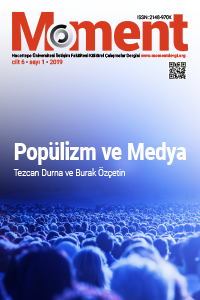Kitap İncelemesi
Kültür, Yaratıcılık ve Endüstri Gerilimleri Arasında Dijital Oyunlar
Öz
--
Anahtar Kelimeler
Kaynakça
- Banks, M. and O’Connor, J. (2009). After the Creative Industries. International Journal of Cultural Policy, 15 (4), 365- 373.
- Bustamante, E. (2004). Cultural Industries in A Digital Age: Some Provisional Conclusions. Media, Culture and Society, (26) 6, 803- 820.
- Cunningham (2002). From Cultural to Creative Industries: Theory, Industry and Policy Implications. Media International Australia, (102) 1, 54- 65.
- DCMS. (2016). Creative Industries: Focus on Employment. Retrieved from: https://www.gov.uk/government/statistics/creative-industries-2016-focus-on
- Galloway, S. and Dunlop, S. (2007). A Critique of Definitions of The Cultural and Creative Industries in Public Policy. International Journal of Cultural Policy, (13) 1, 17- 31.
- Garnham, N. (2000). Emancipation, the Media and Modernity: Arguments About the Media and Social Theory. New York: Oxford University Press.
- Hesmondhalgh, D. (2013). The Cultural Industries. London: Sage.
- Horkheimer, M. and Adorno, T. (2002). Dialectic of Enlightenment. Stanford: Stanford University Press.
- Kerr, A. (2006). The Business and Culture of Digital Games: Gamework/Gameplay. London: Sage.
- Kerr, A. and Cawley, A. (2012). The Spatialisation Of the Digital Games Industry: Lessons from Ireland. International Journal of Cultural Policy, 18 (4), 398– 418.
- Kerr, A. (2016). Recruitment, Work, and Identity in Community Management: Passion, Precarity, and Play. Juliet Webster and Kieth Randle (Eds), in, Virtual Workers and the Global Labour Market. UK: Palgrave MacMillan.
- Kerr, A. (2017). Global Games: Production, Circulation and Policy in the Networked Era. New York: Routledge
- Lefebvre, H. (1991). The Production of Space. Oxford: Blackwell.
- Miege, B. (2011). Principal Ongoing Mutations of Cultural and Informational Industries. Dwayne Winseck and Dal Yong Jin (Eds.), in, The Political Economies of Media (p. 51- 65). London: Bloomsbury Academic.
- Smith, C. and McKinlay, A. (Eds.), (2009). Creative Labour: Working in the Creative Industries. Basingstoke: Palgrave Macmillan.
- Tokumitsu, M. (2015). Do What You Love and Other Lies About Success and Happiness. New York: Regan Arts.
Digital Games Between the Tensions of Culture, Creativity and Industry
Öz
--
Anahtar Kelimeler
Kaynakça
- Banks, M. and O’Connor, J. (2009). After the Creative Industries. International Journal of Cultural Policy, 15 (4), 365- 373.
- Bustamante, E. (2004). Cultural Industries in A Digital Age: Some Provisional Conclusions. Media, Culture and Society, (26) 6, 803- 820.
- Cunningham (2002). From Cultural to Creative Industries: Theory, Industry and Policy Implications. Media International Australia, (102) 1, 54- 65.
- DCMS. (2016). Creative Industries: Focus on Employment. Retrieved from: https://www.gov.uk/government/statistics/creative-industries-2016-focus-on
- Galloway, S. and Dunlop, S. (2007). A Critique of Definitions of The Cultural and Creative Industries in Public Policy. International Journal of Cultural Policy, (13) 1, 17- 31.
- Garnham, N. (2000). Emancipation, the Media and Modernity: Arguments About the Media and Social Theory. New York: Oxford University Press.
- Hesmondhalgh, D. (2013). The Cultural Industries. London: Sage.
- Horkheimer, M. and Adorno, T. (2002). Dialectic of Enlightenment. Stanford: Stanford University Press.
- Kerr, A. (2006). The Business and Culture of Digital Games: Gamework/Gameplay. London: Sage.
- Kerr, A. and Cawley, A. (2012). The Spatialisation Of the Digital Games Industry: Lessons from Ireland. International Journal of Cultural Policy, 18 (4), 398– 418.
- Kerr, A. (2016). Recruitment, Work, and Identity in Community Management: Passion, Precarity, and Play. Juliet Webster and Kieth Randle (Eds), in, Virtual Workers and the Global Labour Market. UK: Palgrave MacMillan.
- Kerr, A. (2017). Global Games: Production, Circulation and Policy in the Networked Era. New York: Routledge
- Lefebvre, H. (1991). The Production of Space. Oxford: Blackwell.
- Miege, B. (2011). Principal Ongoing Mutations of Cultural and Informational Industries. Dwayne Winseck and Dal Yong Jin (Eds.), in, The Political Economies of Media (p. 51- 65). London: Bloomsbury Academic.
- Smith, C. and McKinlay, A. (Eds.), (2009). Creative Labour: Working in the Creative Industries. Basingstoke: Palgrave Macmillan.
- Tokumitsu, M. (2015). Do What You Love and Other Lies About Success and Happiness. New York: Regan Arts.
Toplam 16 adet kaynakça vardır.
Ayrıntılar
| Birincil Dil | İngilizce |
|---|---|
| Konular | İletişim ve Medya Çalışmaları |
| Bölüm | Kitap İncelemeleri |
| Yazarlar | |
| Yayımlanma Tarihi | 15 Haziran 2019 |
| Gönderilme Tarihi | 15 Haziran 2019 |
| Kabul Tarihi | 15 Haziran 2019 |
| Yayımlandığı Sayı | Yıl 2019 Cilt: 6 Sayı: 1 - Popülizm ve Medya |

